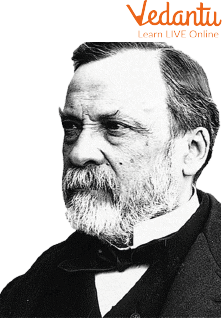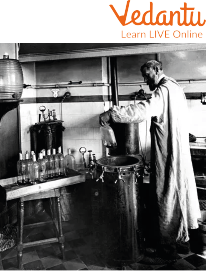




Overview of Louis Pasteur
One of the most significant founders of medical microbiology was Louis Pasteur, a French chemist and microbiologist born in Dole, France on December 27, 1822. He passed away at Saint-Cloud on September 28, 1895. Pasteur made virtually one-of-a-kind contributions to science, technology, and medicine.
He established the pasteurisation procedure, preserved the French wine, beer, and silk industries, pioneered the study of molecular asymmetry, and more. He discovered that bacteria are the source of fermentation and disease, and created vaccinations for rabies and anthrax. Pasteur recognised that bacteria which are causes of various diseases. He discovered vaccination process.
Information About Louis Pasteur
Pasteur was admitted to the École Normale Supérieure (a teachers' institution in Paris) in 1843. There, he assisted Jean-Baptiste-André Dumas in his classes and attended lectures given by the French chemist. In 1845, Pasteur earned his master's in science before going on to earn his doctorate in physical sciences. In 1848, Pasteur obtained a position as a professor of physics at the Lycée de Dijon, but he soon accepted a position as a professor of chemistry at the University of Strasbourg. He wed Marie Laurent, the daughter of the university rector, on May 29, 1849. Only two of the couple's five children made it through childhood.

Louis Pasteur
History of Louis Pasteur
In Dole, France, Pasteur was born as the middle child of five into a family of leather tanners. Up until the end of his secondary school years, the young Pasteur's abilities seemed to be more artistic than scholastic. He pursued intense studies to make up for his scholastic weaknesses in order to get ready for the École Normale Supérieure, the prestigious teachers' college in Paris, spurred on by the encouragement of his mentors. There, he received both his doctorate (1847) and his master's (1845) degrees.
Pasteur continued to work as a lab assistant at the École Normale while he awaited the proper appointment. There, he made more headway on the investigation into the capacity of particular crystals or solutions to rotate plane-polarised light either clockwise or counterclockwise, or to demonstrate "optical activity," that he had started for his PhD dissertation. He was able to demonstrate that this action frequently had a connection to the composition of a compound's crystals. Additionally, he reasoned that the molecules of such a substance had an "asymmetric" internal structure that was unique and responsible for twisting the light. This theory plays a significant role in the early development of structural chemistry, which is the branch of chemistry that examines the three-dimensional properties of molecules.
Pasteur adopted a similar perspective on the origin of diseases at the same time that he started studying fermentation. In the 1860s, Pasteur made an early excursion into the aetiology of certain diseases and was able to pinpoint the origin of the disastrous blight that had befallen the silkworms that were the backbone of France's then-significant silk industry. Surprisingly, he discovered that there were actually two microbes responsible for the crime.

Louis Pasteur Working
Louis Pasteur Discoveries
Some of the most important discoveries of Louis Pasteur are:
Pasteurisation
Packaged and unpackaged food are subjected to a light heating procedure called pasteurisation, which typically involves temperatures of less than 100 °C (212 °F).
Cholera Vaccines
Vaccines against cholera are useful for preventing the disease. They offer about 85% protection for the first six months following immunisation, declining to 50% or 62 per cent throughout the first year. The amount of protection falls to less than 50% after two years.
Rabies Vaccine
A vaccination used to prevent rabies is the rabies vaccine. There are several rabies vaccines that are both reliable and secure. They can be used to stop the spread of the rabies virus, which is typically brought on by a dog bite or a bat bite, before and for a while after exposure.
Louis Pasteur Quotes
"Scientific knowledge is universal because it is the light that illuminates the entire human race, which transcends national boundaries. Because that country will continue to be the first to spread works of thinking and intelligence the farthest, science is the highest personification of the country.”
"Messieurs, it is the microbes who will have the ultimate word," is the correct translation of the line "Gentlemen, it is the germs who will have the final say."
“Effort: Let us be able to say, as we get closer to the big aim, I have done what I could, whether or not life favours our efforts.”
“Science draws people closer to God by increasing our understanding of the natural world and our awe of the Creator's handiwork.”
Interesting Facts About Louis Pasteur
Louis went on to teach chemistry at universities in France. He investigated the bacteria in food and beverages.
He discovered that milk's bacteria can be destroyed by heating. The term "pasteurisation" refers to this action. Today, it makes a lot of our meals safer.
Louis Pasteur developed the cholera, anthrax, smallpox, and rabies vaccinations.
Summary
Louis Pasteur, a French chemist and microbiologist (born December 27, 1822, Dole, France—died September 28, 1895), is regarded as one of the most important pioneers of medical microbiology. Pasteur made virtually one-of-a-kind contributions to science, technology, and medicine. He produced the anthrax and rabies vaccines, discovered that bacteria cause fermentation and disease, pioneered the study of molecular asymmetry, saved the French beer, wine, and silk industries, and more.
Pasteur had a large number of academic positions, and his scientific contributions gained him numerous honours including election to the Académie des Sciences and France's highest accolade, the Legion of Honor. Today, more than 30 institutes, as well as a staggering number of hospitals, schools, structures, and streets, bear his name—a distinction given to only a select few experts.
FAQs on Interesting Facts About Louis Pasteur
1. How did Louis Pasteur discover the rabies vaccine?
Louis Pasteur developed the rabies vaccine by studying the disease in animals. He discovered that the virus was concentrated in the nervous system. To create the vaccine, he used the spinal cords from infected rabbits, weakening the virus by drying the tissue over time. On July 6, 1885, he famously administered this weakened-virus vaccine to a young boy, Joseph Meister, who had been bitten by a rabid dog. The treatment was successful, marking a historic moment in medicine and the creation of one of the first effective post-exposure vaccines.
2. Why is Louis Pasteur called the "Father of Microbiology"?
Louis Pasteur is known as the "Father of Microbiology" because his work revolutionised the understanding of microscopic organisms. His key achievements that earned him this title include:
- Germ Theory of Disease: He was the first to conclusively prove that germs (microbes) cause infectious diseases.
- Disproving Spontaneous Generation: He demonstrated that living organisms come from other living organisms, not from non-living matter.
- Vaccination: He developed the first vaccines for rabies and anthrax, saving countless lives.
- Pasteurisation: He invented the process of heating liquids to kill harmful bacteria, making food and drinks safer.
3. What is pasteurisation and how does it work?
Pasteurisation is a process invented by Louis Pasteur to kill harmful microorganisms in beverages and food. It works by heating the liquid (like milk, juice, or wine) to a specific temperature for a set period, followed by rapid cooling. This process eliminates most of the pathogenic bacteria, such as Salmonella, Listeria, and E. coli, without significantly affecting the taste or nutritional value of the product. It prevents spoilage and makes the food safe for consumption.
4. What were Louis Pasteur's most important scientific contributions?
Louis Pasteur's most important scientific contributions fundamentally changed science and medicine. His major achievements include the development of the germ theory of disease, the invention of pasteurisation to preserve food, the creation of groundbreaking vaccines for rabies and anthrax, and his work on fermentation, which proved that microbes were responsible for the process. He also made significant discoveries in chemistry related to the molecular structure of crystals.
5. How did Louis Pasteur's work on fermentation help industries like wine and beer production?
Louis Pasteur's research on fermentation was a game-changer for the wine, beer, and silk industries. He discovered that microscopic organisms, specifically yeasts, were responsible for converting sugars into alcohol during fermentation. He also found that other microbes, like bacteria, could contaminate the batch, causing the wine or beer to spoil and turn sour. By understanding this, producers could control the process, ensure only the correct yeast was present, and use pasteurisation to prevent spoilage, leading to more consistent and higher-quality products.
6. What common misconception did Louis Pasteur's germ theory of disease disprove?
Louis Pasteur's work directly disproved the long-held theory of spontaneous generation. This was the belief that living organisms could arise spontaneously from non-living matter—for example, that maggots could appear from rotting meat or microbes from broth. Through his famous swan-neck flask experiments, Pasteur proved that microorganisms were present in the air and would only grow in broth if the broth was exposed to them. This established that life only comes from pre-existing life, laying the foundation for modern biology and sterile medical techniques.
7. How are Pasteur's discoveries from the 19th century still important today?
The impact of Louis Pasteur's discoveries is still felt strongly today. Pasteurisation is a standard safety procedure for milk, juice, and other foods worldwide, preventing millions of cases of illness. The principles behind his vaccines are the foundation of modern immunology, which continues to develop new vaccines for diseases. His germ theory is the basis for hygiene, sanitation, and sterile surgical practices in hospitals, which are critical for public health and preventing the spread of infection.
8. Besides rabies, what other diseases did Louis Pasteur help combat with his research?
While the rabies vaccine is his most famous, Louis Pasteur's research was crucial in combating several other diseases. He developed the first effective vaccine against anthrax, a deadly disease that affected livestock like sheep and cattle, saving entire agricultural economies. He also studied and helped prevent fowl cholera in chickens. Furthermore, his work on identifying the microbial cause of pébrine, a disease devastating silkworms, saved the silk industry in France. These successes demonstrated the power of his germ theory and vaccination methods.









